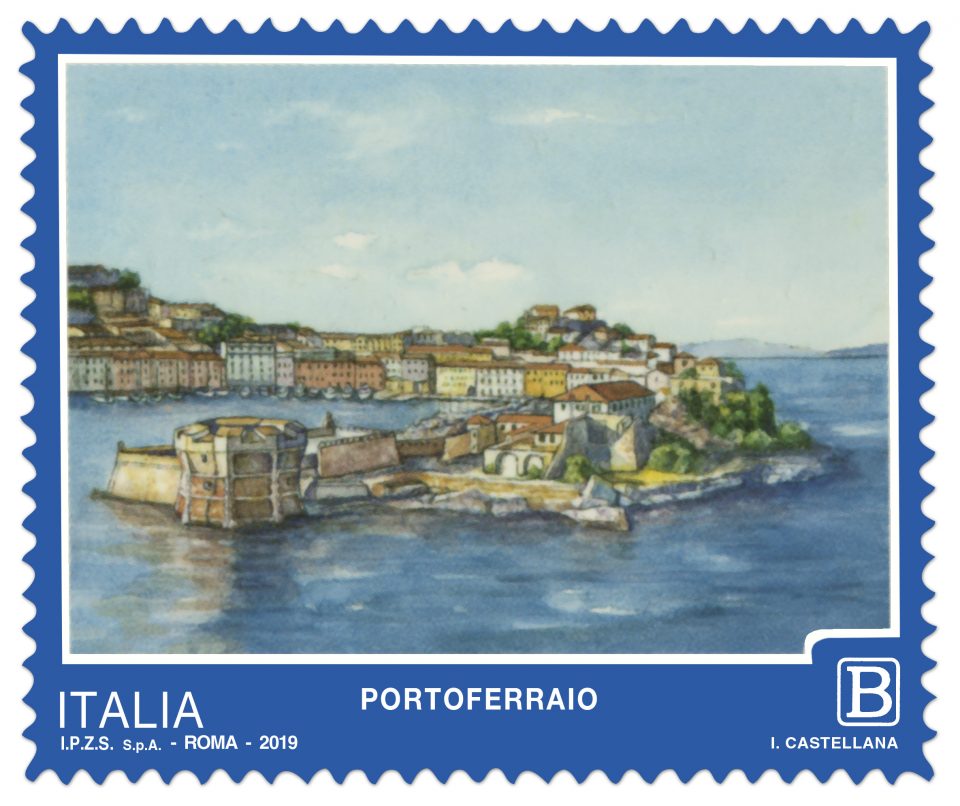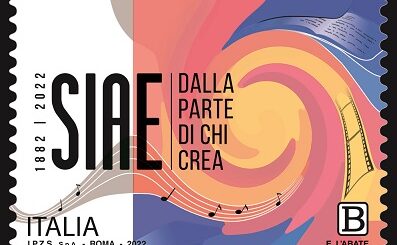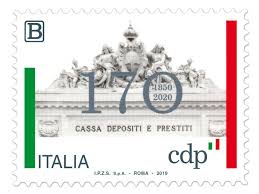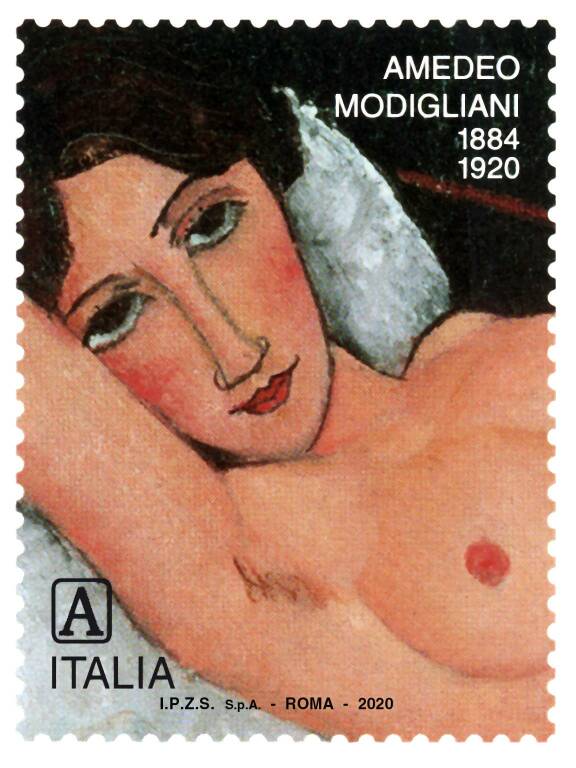POSTE ITALIANE 51^ emissione del 10 Ottobre 2019 di quattro francobolli dedicati al turismo: Troia, Portoferraio, Orbetello e Saluzzo
POSTE ITALIANE 51^ emissione del 10 Ottobre 2019 di quattro francobolli dedicati al turismo: Troia, Portoferraio, Orbetello e Saluzzo

Il Ministero dello Sviluppo ha emesso il 10 ottobre 2019 quattro francobolli ordinari appartenenti alla serie tematica “il Patrimonio naturale e paesaggistico” dedicati alle seguenti località : Troia, Portoferraio, Orbetello e Saluzzo relativi al valore della tariffa B, ognuno corrispondente ad € 1.10.
- data / date 10 Ottobre 2019
- dentellatura / serration 11
- stampa / printing fustellatura/rotocalco
- tipo di carta / paper type bianca patinata neutra
- stampato / printed I.P.Z.S. Roma
- tiratura / edition 400.000
- fogli / sheet 28
- dimensioni / dimension 48 x 40 mm
- costo / price B = € 1,10 cadauno
- bozzettista/ designer Troia: Claudia Giusto; Portoferraio: Isabella Castellana; Orbetello: Tiziana Trinca; Saluzzo: Isabella Castellana.
- num. catalogo Mi YT Troia
- num. catalogo Mi YT Portoferraio
- num. catalogo Mi YT Orbetello
- num. catalogo Mi YT Saluzzo
Portoferraio, è un comune italiano di 11 999 abitanti della provincia di Livorno, primo comune dell’Isola d’Elba per popolazione e secondo per estensione dopo Campo nell’Elba.
STORIA
Secondo Apollonio Rodio, il luogo dove sbarcarono gli Argonauti di Giasone, poiché stavano cercando Circe, si chiamava Porto Argo (Argòos ed è oggi localizzato presso la spiaggia delle Ghiaie. Nell’area si trovano i resti di due ville marittime romane (villa delle Grotte e villa della Linguella) che testimoniano un’assidua frequentazione in età imperiale. Secondo una tradizione letteraria del XVIII secolo, peraltro non attestata da alcun riferimento storico e documentale, in età romana il sito si sarebbe chiamato Fabricia – da cui Borghi Fabbricii – in riferimento alle antiche lavorazioni siderurgiche presenti nella zona. Già dal XVIII secolo furono rinvenute tracce di un insediamento romano presso l’attuale centro storico di Portoferraio; murature in opus reticulatum e opus sectile, lastre di piombo, denarii e tracce di almeno due piccole necropoli collocate presso i Mulini e gli Altesi.
Il toponimo Ferraia o Ferraria è documentato a partire dal 1278 e trae origine dalle attività siderurgiche presenti nell’area sin da epoca etrusco-romana. Il circondario di Ferraia (il cui comune è documentato dal 1289) fu pesantemente colpito nel 1544 dalla flotta di Khayr al-Din Barbarossa, con la distruzione del vicino fortilizio di Montemarsale e della pievemedievale dei Santi Giovanni e Silvestro. Successivamente, il distretto di Ferraia fu ceduto dagli Appiano per ordine dell’imperatore Carlo V ai Medici nel 1547. In cartografie del XVI secolo si registra una mutazione del nome in Ferraio.
Portoferraio fu rifondata per volere di Cosimo I granduca di Toscana nel 1548, affidando all’architetto Giovanni Camerini la progettazione di una città fortificata simbolicamente chiamata Cosmopoli (“città di Cosimo”) concepita come presidio militare con lo scopo di difendere le coste toscane nonché come sede dei Cavalieri di Santo Stefano e che nel 1583 venne così descritta da Giovan Battista Adriani: «Il poggio più elevato, che signoreggia e scuopre tutto il porto, fu chiamato il Falcone: l’altro men rilevato dalla forma della fortezza secondo la qualità del sito hebbe nome la Stella, spargendo le sue fortificazioni qua e là a guisa di razzi. Parimente fermarono un bastione sopra la bocca del porto, il quale fu chiamato dalla forma Linguella.» L’epigrafe marmorea che il granduca fece apporre sulla cosiddetta Porta a Mare, l’ingresso principale del porto, descrive infatti la fondazione della nuova città: «Templa, moenia, domus, arces, portum Cosmus florentinorum dux a fundamentis erexit a. D. MDXXXXVIII».
La città, exclave toscana nel Principato di Piombino, all’inizio era poco più che un insieme di fortificazioni (ancora tutt’oggi visitabili e ben conservate), come i tre forti: Forte Stella, Forte Falcone e la Linguella (mentre Forte Inglese fu realizzato successivamente per rinforzare la cittadina in vista dell’assedio della flotta britannica) e la bellissima cinta muraria, i cui resti, tuttora in buono stato e resi abitabili, circondano il centro storico di Portoferraio. Ancora oggi è in gran parte visibile l’imponente cortina di bastioni che dalla rada si eleva fino al Forte del Falcone (Bastione della Cornacchia a difesa dell’antica Porta a Terra, Bastione delle Palle di sotto che dalla Porta degli Altesi dava accesso al superiore Bastione delle Palle di sopra, Cortina degli Altesi, Bastione del Veneziano, Opera del Raggione, Opera del Cavaliere, Tanaglia sotto il Falcone, Opera nuova, Opera di Santa Fine, Batteria degli Spagnoli di fronte alla spiaggia delle Ghiaie). Nel 1694, ad opera del governatore Mario Tornaquinci, fu realizzato il cosiddetto Ponticello, una struttura – poi demolita nel gennaio 1925 – sul fossato artificiale che separava la città fortificata dal resto dell’isola. Nell’anno 1700 furono lastricate le vie del centro storico, per volere del governatore Benedetto Guerrini, con bozze irregolari di calcare compatto rosato estratto nelle cave marittime di Punta Pina e Punta degli Scalpellini, i due promontori che chiudono la vicina insenatura di Bagnaia. Tale caratteristica, nel passato, ha suggerito l’epiteto di «Città rosa» dato a Portoferraio.
La città rimase sotto il controllo del Granducato di Toscana fino al XVIII secolo quando l’isola, per la sua posizione strategica, fu al centro di una guerra tra Francia, Austria e Inghilterra. Con un decreto del 1702, il governatore Alessandro Del Nero istituì la realizzazione di un ghetto presso il Forte Stella, nella strada che poi prese il nome di via degli Ebrei. Nell’aprile 1814, con il Trattato di Fontainebleau, l’isola fu affidata a Napoleone Bonaparte come sede del suo primo esilio. Napoleone scelse Portoferraio come capoluogo dell’isola; nella città sono ancora presenti e visitabili le due ville che furono sua residenza, quella di San Martino e la Villa dei Mulini. Fu grazie al regno dell’imperatore francese, seppur breve (1814-1815), che Portoferraio crebbe in importanza e modernità in maniera esponenziale, come tutta l’isola del resto, grazie alle infrastrutture create e alla valorizzazione delle miniere di ferro di Rio Marina. In questo periodo Portoferraio divenne il porto adibito al trasporto del ferro dalle miniere elbane al continente, e da ciò deriva il nome attuale. Successivamente Portoferraio tornò sotto il dominio del Granducato di Toscana fino all’unità d’Italia nel 1860. Nei «Bagni penali» della città fu rinchiuso Giovanni Passannante, a causa di un attentato nei confronti di Umberto I di Savoia.
Il 13 dicembre 1900, per interessamento dell’onorevole Pilade Del Buono, fu posta la prima pietra di un quartiere siderurgico con altiforni della società Ilva, poi distrutto durante i bombardamenti della seconda guerra mondiale; l’Ilva acquistò dal Demanio l’area delle vecchie saline per un costo di 140 000 lire. Tra il 1902 e il 1904 l’architetto Adolfo Coppedè progettò a Portoferraio alcuni importanti edifici, come il Palazzo dei Merli in stile neoquattrocentesco (1904) poi distrutto dai bombardamenti del 1944, il Palazzo degli Altiforni (1904) e la Fattoria di San Martino (1902).
Portoferraio conobbe un periodo economicamente stabile, come tutta l’isola, grazie alle miniere di ferro fino agli inizi degli anni settanta, quando l’industria del ferro entrò in crisi. Nel 1958, nell’area portuale di Portoferraio, fu realizzata dall’architetto Emilio Isotta la cosiddetta «Palazzata a mare», che con il suo contestato grattacielo caratterizzato da guglie metalliche doveva simbolicamente evocare il passato siderurgico della cittadina.
Nonostante la chiusura delle miniere di ferro all’Elba (1981), Portoferraio, grazie alle sue spiagge, seppe riciclarsi nell’industria del turismo che ancora oggi rappresenta la principale fonte di ricchezza.
Se sei interessato all’acquisto di questo francobollo lo puoi acquistare al prezzo di €1.50. Inviami una richiesta alla email: protofilia1@gmail.com

Portoferraio, is an Italian town of 11 999 inhabitants in the province of Livorno, the first town on the Island of Elba by population and second by extension after Campo nell’Elba.
HISTORY
According to Apollonio Rodio, the place where the Argonauts of Jason disembarked, because they were looking for Circe, was called Porto Argo (Argòos and is today located near the beach of Ghiaie. In the area there are the remains of two Roman maritime villas (villa delle Grotte and Villa della Linguella) which testify to an assiduous frequentation in the imperial age. According to a literary tradition of the XVIII century, which was not attested by any historical or documentary reference, in Roman times the site was called Fabricia – from which Borghi Fabbricii – in reference to the ancient iron and steel works present in the area, traces of a Roman settlement near the current historic center of Portoferraio have been found since the 18th century, opus reticulatum and opus sectile masonry, lead slabs, denarii and traces of at least two small necropolises located near the Mills and the Altesi.
The toponym Ferraia or Ferraria is documented starting from 1278 and originates from the iron and steel activities present in the area since the Etruscan-Roman period. The district of Ferraia (whose municipality has been documented since 1289) was heavily hit in 1544 by the fleet of Khayr al-Din Barbarossa, with the destruction of the nearby fortress of Montemarsale and the pievemedievale of the Saints Giovanni and Silvestro. Subsequently, the district of Ferraia was ceded by the Appiano by order of the Emperor Charles V to the Medici in 1547. In maps of the sixteenth century there is a mutation of the name in Ferraio.
Portoferraio was re-founded at the behest of Cosimo I the Grand Duke of Tuscany in 1548, entrusting the architect Giovanni Camerini with the design of a fortified city symbolically called Cosmopoli (“city of Cosimo”) conceived as a military garrison with the aim of defending the Tuscan coasts as well as seat of the Knights of Santo Stefano and which in 1583 was thus described by Giovan Battista Adriani: «The highest hill, which dominates and unveils the entire port, was called the Falcone: the other men detected by the shape of the fortress according to the quality of the site called the Stella, spreading its fortifications here and there like rockets. Likewise they stopped a bastion over the mouth of the port, which was called by the Linguella form. “The marble epigraph that the Grand Duke had affixed to the so-called Porta a Mare, the main entrance to the port, describes the foundation of the new city:” Templa, moenia, domus, arces, portum Cosmus florentinorum dux a fundamentis erexit a. D. MDXXXXVIII ».
The city, a Tuscan exclave in the Principality of Piombino, at the beginning was little more than a collection of fortifications (still visible and well preserved), like the three forts: Forte Stella, Forte Falcone and Linguella (while Forte Inglese was subsequently built to reinforce the town in view of the siege of the British fleet) and the beautiful city walls, whose remains, still in good condition and made habitable, surround the historic center of Portoferraio. Even today, the imposing curtain of ramparts that from the harbor rises up to the Fort of Falcone (Bastione della Cornacchia in defense of the ancient Porta a Terra, Bastione delle Palle below which from the Porta degli Altesi gave access to the upper one) is visible from the harbor. Bastione delle Palle di sopra, Cortina degli Altesi, Bastion of the Venetian, Opera del Raggione, Work of the Knight, Tanaglia under the Falcone, new work, Work of Santa Fine, Battery of the Spaniards in front of the Ghiaie beach). In 1694, by the governor Mario Tornaquinci, the so-called Ponticello was built, a structure – later demolished in January 1925 – on the artificial moat that separated the fortified city from the rest of the island. In the year 1700 the streets of the historic center were paved, at the behest of the governor Benedetto Guerrini, with irregular drafts of compact rosé limestone extracted in the maritime quarries of Punta Pina and Punta degli Scalpellini, the two headlands that close the nearby inlet of Bagnaia. This characteristic, in the past, suggested the epithet of “Pink City” given to Portoferraio.
The city remained under the control of the Grand Duchy of Tuscany until the eighteenth century when the island, due to its strategic position, was at the center of a war between France, Austria and England. With a decree of 1702, the governor Alessandro Del Nero established the construction of a ghetto near the Forte Stella, in the street that then took the name of Via degli Ebrei. In April 1814, with the Treaty of Fontainebleau, the island was entrusted to Napoleon Bonaparte as the site of his first exile. Napoleon chose Portoferraio as the island’s capital; in the city the two villas that were his residence are still present and can be visited, that of San Martino and the Villa dei Mulini. It was thanks to the reign of the French emperor, albeit brief (1814-1815), that Portoferraio grew in importance and modernity exponentially, like the rest of the island, thanks to the infrastructures created and the exploitation of the iron mines of Rio Marina . In this period Portoferraio became the port used to transport iron from the Elban mines to the continent, and from this derives the current name. Later Portoferraio returned under the dominion of the Grand Duchy of Tuscany until the unification of Italy in 1860. Giovanni Passannante was imprisoned in the “Pena On December 13, 1900, due to the interest of the Honorable Pilade Del Buono, the first stone of a steelworks with blast furnaces of the Ilva company was laid, then destroyed during the bombings of the Second World War; Ilva bought from the State Property area of the old salt pans for a cost of 140 000 lire. Between 1902 and 1904 the architect Adolfo Coppedè designed in Portoferraio some important buildings, such as the Palazzo dei Merli in the fifteenth-century style (1904) then destroyed by bombing in 1944, the Palazzo degli Altiforni (1904) and the Fattoria di San Martino ( 1902).
Portoferraio experienced an economically stable period, like the whole island, thanks to the iron mines until the early seventies, when the iron industry went into crisis. In 1958, in the port area of Portoferraio, the so-called «Palazzata a mare» was built by the architect Emilio Isotta, who with his disputed skyscraper characterized by metal spiers was to symbolically evoke the town’s iron and steel past.
Despite the closure of the iron mines on Elba (1981), Portoferraio, thanks to its beaches, was able to recycle itself in the tourism industry which still today represents the main source of wealth. l Baths” of the city, due to an attack against Umberto I of Savoy.
On December 13, 1900, due to the interest of the Honorable Pilade Del Buono, the first stone of a steelworks with blast furnaces of the Ilva company was laid, then destroyed during the bombings of the Second World War; Ilva bought from the State Property area of the old salt pans for a cost of 140 000 lire. Between 1902 and 1904 the architect Adolfo Coppedè designed in Portoferraio some important buildings, such as the Palazzo dei Merli in the fifteenth-century style (1904) then destroyed by bombing in 1944, the Palazzo degli Altiforni (1904) and the Fattoria di San Martino ( 1902).
Portoferraio experienced an economically stable period, like the whole island, thanks to the iron mines until the early seventies, when the iron industry went into crisis. In 1958, in the port area of Portoferraio, the so-called «Palazzata a mare» was built by the architect Emilio Isotta, who with his disputed skyscraper characterized by metal spiers was to symbolically evoke the town’s iron and steel past.
Despite the closure of the iron mines on Elba (1981), Portoferraio, thanks to its beaches, was able to recycle itself in the tourism industry which still today represents the main source of wealth.
If you are interested in buying the stamp you can buy it for € 1.50. Send me a request to the email: protofilia1@gmail.com

- data / date 10 Ottobre 2019
- dentellatura / serration 11
- stampa / printing fustellatura/rotocalco
- tipo di carta / paper type bianca patinata neutra
- stampato / printed I.P.Z.S. Roma
- tiratura / edition 400.000
- fogli / sheet 28
- dimensioni / dimension 48 x 40 mm
- costo / price B = € 1,10 cadauno
- bozzettista/ designer Troia: Claudia Giusto; Portoferraio: Isabella Castellana; Orbetello: Tiziana Trinca; Saluzzo: Isabella Castellana.
- num. catalogo Mi YT Troia
- num. catalogo Mi YT Portoferraio
- num. catalogo Mi YT Orbetello
- num. catalogo Mi YT Saluzzo






